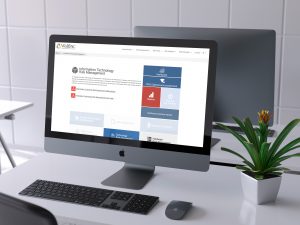Why Automated Risk Management Beats Spreadsheets and Manual Methods
Automated risk management can be a powerful tactic for growing financial institutions (FIs).

Leading a risk management program at a regional or community financial institution isn’t easy. Cybersecurity threats, vendor management, and regulatory changes all contribute to an increasingly complex risk landscape.
Nonetheless, many FIs still rely on manual – and often outdated – methods to assess their risk and prepare for regulatory exams. While familiar and cost-effective, running your entire risk management program in Excel can pose significant challenges that put your institution at risk.
For a variety of reasons, relying solely on manual methods and spreadsheets to conduct and track risk assessments is inherently riskier. That’s not to say that every spreadsheet is useless; some spreadsheets are perfectly acceptable for operational purposes. Overall, automated risk management technology reduces human error and provides more support for busy risk management teams at FIs.
Let’s answer some FAQs and dive deeper into the benefits of automated risk management:
What is automated risk management?
Automated risk management is a process in which organizations leverage software and automation technology to better and more quickly identify, assess, and mitigate risks. Integrated risk management software can help automate aspects of the risk assessment, tracking, and reporting process to free up risk management professionals for more strategic initiatives.
Risk management teams at FIs have to cover a lot of ground as they conduct risk assessments and prepare for regulatory exams. Automated risk management technology can help provide alerts for out-of-date assessments and new regulations, and offer helpful reminders to reinforce best practices.
What is the automated risk management process?
The automated risk management process is how leading organizations combine the expertise of their employees with the efficiency of integrated risk management software. It’s all about creating a human-led, technology-empowered approach; one that uses technology to automate manual tasks while still leaving room for human oversight.
An automated risk management process leads to greater efficiency, better reporting, and less duplicative work.
Preparing for a Regulatory Exam? Read Our Free Guide
Why manual methods and spreadsheets just don’t cut it
We’ll throw in one more disclaimer: not all spreadsheets are bad. But over-reliance on them can hold back your risk management program.
Here’s why:
- Human Error: Let’s face it: humans make mistakes. Spreadsheets leave room for errors during data entry, formatting, and reporting. A single mistake can spawn inaccurate conclusions or skew your risk assessments.
- Lack of Version Control: The version of the spreadsheet you just sent via email could be different than the one your colleague has saved on his or her desktop. Working with out-of-date or inconsistent information can be costly — and it’s difficult for multiple people to work on the same spreadsheet simultaneously.
- Limited Functionality: Even the best spreadsheet likely isn’t designed for complex risk assessments. It’s difficult to comprehensively analyze and mitigate risks without advanced modeling, scenario planning, or automated reporting.
- Difficult Reporting: Producing reports from spreadsheets is time-consuming. This can delay risk communication with regulators before exams, and with senior management.
- Lack of Scalability: Spreadsheets don’t scale with your institution as you grow. The sheer volume of data your FI is handling might become unwieldy over time.
Whether it’s duplicative work, unsatisfactory exam findings, or general frustration, the toll of these downsides can add up quickly.
How an automated process changes the game
Now let’s compare and contrast that to the benefits of leaning into automated risk management practices:
- High Level of Customization: Unlike spreadsheets, automated risk management solutions offer levers that adapt to your FI’s workflows and processes. You’ll have the tools to scale your risk management program as your FI grows.
- Automated Workflows: Streamline risk assessments, tracking, and reporting to free up valuable time for your staff.
- Centralized Data: Create a “single source of truth” for all of your risk-related data. Visibility increases when you’ve consolidated your data on a single platform.
- Real-Time Monitoring: Automated alerts help notify your team of outdated risk assessments and any changes in the regulatory environment that might be on the horizon.
- Efficient Reporting: Generate compliance reports and risk assessments that allow for smooth communication with your C-Suite, board members, and regulatory examiners.
WolfPAC: automated risk management for your FI

WolfPAC is an integrated risk management solution that provides powerful automated risk management technology for financial institutions, healthcare organizations, and FinTechs.
Backed by expertise from over 300 consultants, auditors, and experts at Wolf. & Co., WolfPAC elevates your team from the traditional spreadsheet by providing automated functionality to keep you educated and on track.
Is your FI preparing for a regulatory exam soon? If so, WolfPAC has you covered. Our free eBook, “Preparing for FI Regulatory Exams: A Guide for Risk Management Pros,” equips you with the tools and strategies you need to receive favorable findings on your exams and build a more sustainable risk management strategy
Download your copy here, or visit www.wolfpacsolutions.com to discover how our integrated risk management solution can power your FI.
